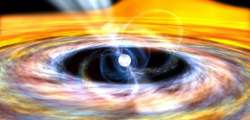Find out the latest thinking about our universe.
-
bystander
- Apathetic Retiree
- Posts: 21577
- Joined: Mon Aug 28, 2006 2:06 pm
- Location: Oklahoma
Post
by bystander » Mon Jun 06, 2016 1:31 pm
 HEAPOW: Truncating the Disk (2016 Jun 06)
HEAPOW: Truncating the Disk (2016 Jun 06)
Neutron stars are incredibly small, massive and dense objects, the crushed cores left behind after the supernova explosion of a star which has at least 8 times the mass of the Sun. Typically, neutron stars pack the mass of the Sun into a sphere of only a few kilometers across, and are so dense that one teaspoonful of neutron star material has as much mass as the entire human population of earth. Some neutron stars are members of binary systems, orbited by a normal star. In these binaries, the neutron star's intense gravity can
strip gas from the normal star onto the neutron star. This gas flows in a stream and spirals onto the neutron star, forming a thin, extensive, hot accretion disk around the neutron star. As material falls onto the neutron star, it heats up to temperatures of millions of degrees, producing X-ray emission. A recent study using X-ray data from NASA's
NuSTAR and
Swift high energy space observatories has provided important new information on the structure of the disk in an important
X-ray binary,
Aquila X-1, and new details of the accretion process. The image above shows an illustration of the accretion disk in Aql X-1 surrounding the neutron star. The inset shows data from NuSTAR (in black) and Swift (in red) of X-ray emission produced by iron atoms in the accretion disk. The symmetrical shape of this emission with energy indicates that the emitting material does not exist close to the neutron star's surface, since, if it were close,
distortions of spacetime near the neutron star would
distort the shape of the iron emission. Astronomers believe that the strong magnetic field of the neutron star in Aql X-1 truncates the inner edge of the accretion disk far from the neutron star's surface, as shown in the illustration above. However, variations in the X-ray emission from Aql X-1 shows that disk material does fall onto the neutron star somehow; most likely this material is channeled by the neutron star's magnetic field from the disk onto the neutron star's
solid iron surface.
Know the quiet place within your heart and touch the rainbow of possibility; be
alive to the gentle breeze of communication, and please stop being such a jerk. — Garrison Keillor
-
bystander
- Apathetic Retiree
- Posts: 21577
- Joined: Mon Aug 28, 2006 2:06 pm
- Location: Oklahoma
Post
by bystander » Mon Jun 06, 2016 1:39 pm
Where a Neutron Star’s Accretion Disk Ends
Nova | American Astronomical Society | 2016 Mar 16
[img3="Artist’s impression of a neutron star accreting gas in a binary system. Material funnels from the companion star into an accretion disk surrounding the neutron star. (Credit: NASA/GSFC/Dana Berry)"]http://aasnova.org/wp-content/uploads/2016/03/fig16.jpg[/img3][hr][/hr] In X-ray binaries that consist of a neutron star and a companion star, gas funnels from the companion into an accretion disk surrounding the neutron star, spiraling around until it is eventually accreted. How do the powerful magnetic fields threading through the neutron star affect this accretion disk? Recent observations provide evidence that they may push the accretion disk away from the neutron star’s surface.
Theoretical models have indicated that neutron star accretion disks may not extend all the way in to the surface of a neutron star, but may instead be truncated at a distance. This prediction has been difficult to test observationally, however, due to the challenge of measuring the location of the inner disk edge in neutron-star X-ray binaries.
In a new study, however, a team of scientists led by Ashley King (Einstein Fellow at Stanford University) has managed to measure the location of the inner edge of the disk in Aquila X-1, a neutron-star X-ray binary located 17,000 light-years away. ...
Measuring a Truncated Disk in Aquila X-1 - Ashley L. King
et al
Know the quiet place within your heart and touch the rainbow of possibility; be
alive to the gentle breeze of communication, and please stop being such a jerk. — Garrison Keillor
-
neufer
- Vacationer at Tralfamadore
- Posts: 18805
- Joined: Mon Jan 21, 2008 1:57 pm
- Location: Alexandria, Virginia
Post
by neufer » Mon Jun 06, 2016 3:25 pm
https://en.wikipedia.org/wiki/Single_%28music%29 wrote:
<<The most common form of the vinyl single is the 45 or 7-inch. The names are derived from its play speed, 45 rpm, and the standard diameter, 7 inches.
The 7-inch 45-rpm record was released March 31, 1949 by RCA as a smaller, more durable and higher-fidelity replacement for the 78 rpm shellac discs. The first 45-rpm records were monaural, with recordings on both sides of the disc. As stereo recordings became popular in the 1960s, almost all 45-rpm records were produced in stereo by the early 1970s. The first 45 rpm record created was "PeeWee the Piccolo" RCA 47-0146 pressed Dec. 7, 1948.>>
Art Neuendorffer
 HEAPOW: Truncating the Disk (2016 Jun 06)
HEAPOW: Truncating the Disk (2016 Jun 06)
